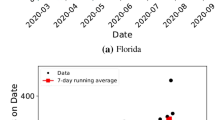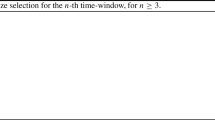Abstract
Forecasting the transmission patterns of infectious diseases is of paramount importance in gaining valuable insights into outbreak growth and optimizing the allocation of medical resources. In this paper, we conduct a comparative study between a physics-based model and a machine learning (ML) model for epidemic forecasting and countermeasures, considering criteria such as accuracy and practicality. We develop four ML models: back-propagation (BP), long short-term memory, support vector machine, and extreme learning machine. In addition, we propose a reaction–diffusion (R–D) model that incorporates factors such as susceptibility heterogeneity, lockdown measures, population movement, and dynamically dependent rates. The experimental results highlight the superior accuracy of the BP model for forecasting, while the R–D model provides comprehensive insights into disease dynamics, including stability and potential control strategies.










Similar content being viewed by others
Data Availability
Data will be made available on request.
References
Aguiar M, Van-Dierdonck JB, Mar J, Stollenwerk N (2022) The role of mild and asymptomatic infections on COVID-19 vaccines performance: a modeling study. J Adv Res 39:157–166
Canada to allow family of citizens across U.S. border amid COVID-19 shutdown. https://globalnews.ca/news/472 7039072/coronavirus-canada-us-border-exception. Accessed 28 Mar 2024
Chen S, Yu J (2016) Stability analysis of a reaction-diffusion equation with spatiotemporal delay and Dirichlet boundary condition. J Dyn Differ Equ 28(3):857–866
Clement JC, Ponnusamy V, Sriharipriya K, Nandakumar R (2021) A survey on mathematical, machine learning and deep learning models for COVID-19 transmission and diagnosis. IEEE Rev Biomed Eng 15:325–340
David J, Bragazzi NL, Scarabel F, McCarthy Z, Wu J (2022) Non-pharmaceutical intervention levels to reduce the COVID-19 attack ratio among children. R Soc Open Sci 9(3):211863
Gourley S, Britton N (1996) A predator-prey reaction-diffusion system with nonlocal effects. J Math Biol 34(3):297–333
Lalmuanawma S, Hussain J, Chhakchhuak L (2020) Applications of machine learning and artificial intelligence for Covid-19 (SARS-CoV-2) pandemic: a review. Chaos Solitons Fractals 139:110059
Many provinces, territories enforcing border checkpoints and travel restrictions. https://www.cbc.ca/news/484 canada/coronavirus-checkpoints-travel-restrictions-border-province-1.5522467. Accessed 28 Mar 2024
Masum M, Masud M, Adnan MI, Shahriar H, Kim S (2022) Comparative study of a mathematical epidemic model, statistical modeling, and deep learning for COVID-19 forecasting and management. Socio-Econ Plan Sci 80:101249
Pao CV, Ruan WH (2013) Quasilinear parabolic and elliptic systems with mixed quasimonotone functions. J Differ Equ 255(7):1515–1553
Rasjid ZE, Setiawan R, Effendi A (2021) A comparison: prediction of death and infected COVID-19 cases in Indonesia using time series smoothing and LSTM neural network. Procedia Comput Sci 179:982–988
Reopening Ontario – Stage 1: Select Businesses Reopen May 16 and 19. https://filion.on.ca/insights/reopening-ontario-stage-1-select-businesses-reopen-may-16-and-19/. Accessed 28 Mar 2024
Rudin C (2019) Stop explaining black box machine learning models for high stakes decisions and use interpretable models instead. Nat Mach Intell 1(5):206–215
Shi Q, Shi J, Wang H (2021) Spatial movement with distributed memory. J Math Biol 82(4):1–32
Tao Y, Ren J (2022) The stability and bifurcation of homogeneous diffusive predator–prey systems with spatio-temporal delays. Discrete Contin Dyn Syst B 27(1):229
Tao Y, Campbell SA, Poulin FJ (2021) Dynamics of a diffusive nutrient-phytoplankton-zooplankton model with spatio-temporal delay. SIAM J Appl Math 81(6):2405–2432
Tao Y, Sun Y, Zhu H, Lyu J, Ren J (2023) Nilpotent singularities and periodic perturbation of a GI\(\beta \) model: a pathway to glucose disorder. J Nonlinear Sci 33(3):49
Tomar A, Gupta N (2020) Prediction for the spread of COVID-19 in India and effectiveness of preventive measures. Sci Total Environ 728:138762
Vadyala SR, Betgeri SN, Sherer EA, Amritphale A (2021) Prediction of the number of COVID-19 confirmed cases based on K-means-ISTM. Array 11:100085
Weitz JS, Beckett SJ, Coenen AR, Demory D, Dominguez-Mirazo M, Dushoff J, Leung C, Li G, Măgălie A, Park SW et al (2020) Modeling shield immunity to reduce COVID-19 epidemic spread. Nat Med 26:849–854
Xue L, Jing S, Zhang K, Milne R, Wang H (2022) Infectivity versus fatality of SARS-CoV-2 mutations and influenza. Int J Infect Dis 21:195–202
Acknowledgements
This research is supported by the National Natural Science Foundation of China (12201577, U23A2065, 52071298), Key Scientific and Technological Project of Henan Province (232102320136).
Author information
Authors and Affiliations
Contributions
Yiwen Tao: formal analysis, data curation, methodology, writing. Huaiping Zhu: conceptualization, validation, writing. Jingli Ren: supervision, conceptualization, formal analysis, methodology, validation, and writing.
Corresponding author
Ethics declarations
Conflict of interest
The authors declare that they have no conflict of interest.
Additional information
Publisher's Note
Springer Nature remains neutral with regard to jurisdictional claims in published maps and institutional affiliations.
Rights and permissions
Springer Nature or its licensor (e.g. a society or other partner) holds exclusive rights to this article under a publishing agreement with the author(s) or other rightsholder(s); author self-archiving of the accepted manuscript version of this article is solely governed by the terms of such publishing agreement and applicable law.
About this article
Cite this article
Tao, Y., Zhu, H. & Ren, J. Comparative study of physics-based model and machine learning model for epidemic forecasting and countermeasure. Comp. Appl. Math. 43, 148 (2024). https://doi.org/10.1007/s40314-024-02654-1
Received:
Revised:
Accepted:
Published:
DOI: https://doi.org/10.1007/s40314-024-02654-1




